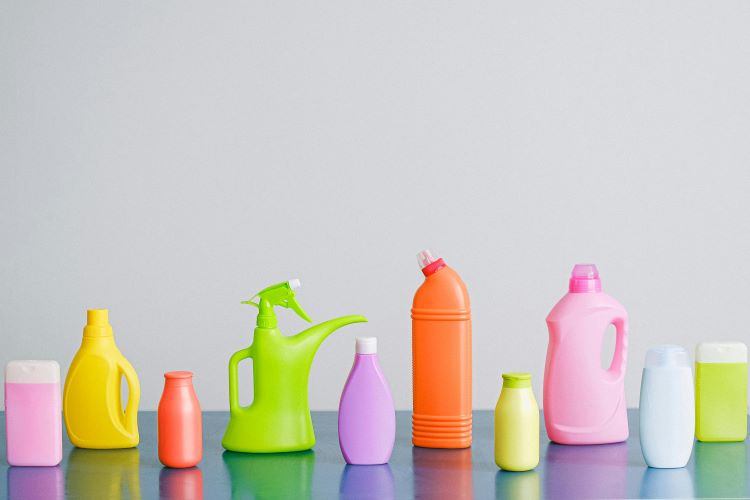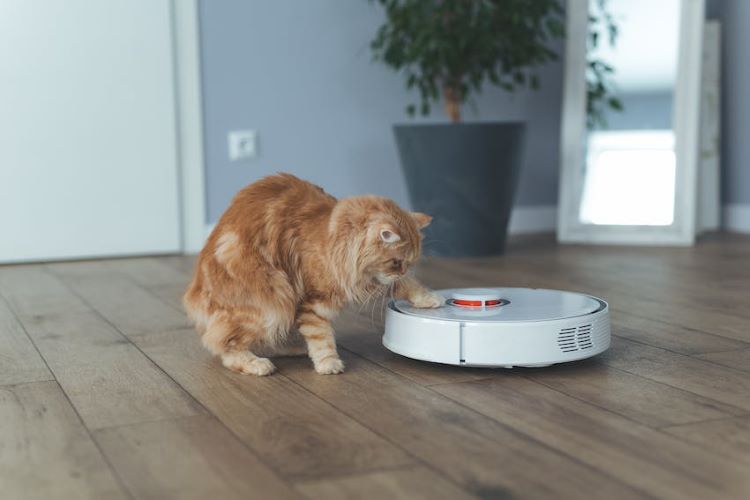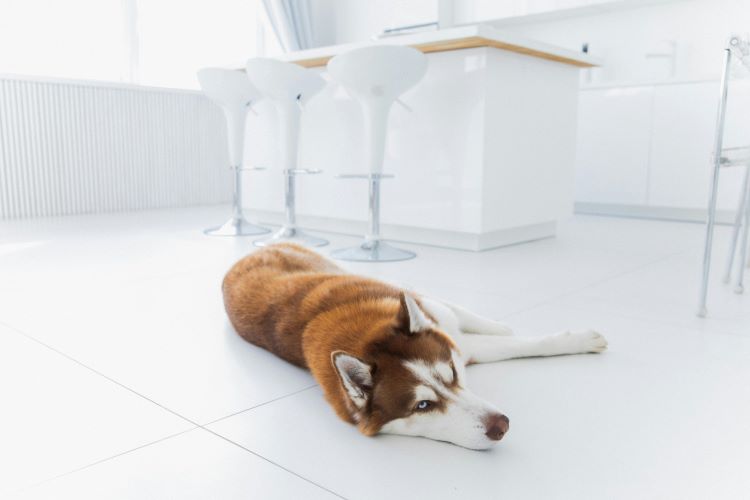Ready to help treat your pet to a healthy life?
All About Pet-Safe Cleaning Products
By : Brianna Gunter | Updated Apr 29, 2025

Humans and pets alike deserve to live in a clean, healthy environment, but what do you do when your pet could get harmed by the very substances used to clean your home? Many common household cleaning products contain ingredients toxic to dogs and cats. If you’re not careful, you could end up causing significant damage to your pal’s health just by making your home sparkle.
Since nobody wants to visit the emergency animal hospital — or live in a dirty house — it’s important to stick to pet-safe cleaning products. Whether you’re a dog owner, cat owner, or have another pet friend at home, the best time to learn how to choose non-toxic cleaners and avoid risks is always the present. So before you pick up the disinfectant spray, take the tips in this guide to heart.
Common cleaning agents and your pet’s health
According to ASPCA Animal Poison Control Center, 6.5% of pet poison calls in 2024 were due to exposure to household products. While this percentage has fluctuated in the years since, the fact remains that many pet households contain a variety of common items with potentially toxic ingredients. Ammonia, bleach, and various surfactants are all toxic to dogs and cats, yet are often found in many all-purpose cleaners, window cleaners, and dishwashing detergents.
The really hazardous thing about cleaning substances is that they don’t necessarily have to be ingested to be harmful. Pets can easily suffer reactions through inhalation or direct paw/skin exposure. Ammonia, for example, is found in many glass cleaners and can irritate the respiratory tract if breathed in. Many air fresheners and fabric refreshers likewise contain volatile organic compounds (VOCs) that can do the same. Similarly, bleach can cause skin irritation, chemical burns or sometimes even internal damage just by coming into contact with a pet's skin or eyes.
Even seemingly innocuous items like carpet cleaners or furniture polish may contain ingredients harmful to pets if ingested or inhaled. If you think your pet has consumed or come into contact with cleaning products, contact your veterinarian or the Pet Poison Helpline right away for further advice.
Toxic side effects from cleaning products for pets
The potential consequences for dogs and cats that ingest, touch or inhale toxic cleaning substances range from mild to severe.
- Skin irritation (redness, itching, sores)
- Respiratory irritation (coughing, gagging, wheezing)
- Gastrointestinal upset (including vomiting and diarrhea)
- Seizures
- Respiratory infection
- Chemical burns
- Liver failure
- Kidney failure
Dangers for dogs
Dogs explore the world with their noses and mouths — all the more reason to switch to pet-friendly cleaning products. They may also lick their paws and fur, which can result in toxic substance ingestion if they are allowed into a recently cleaned or treated space. Likewise, dogs who enjoy licking certain textures and/or surfaces are at extra risk if they lick something shortly after it is cleaned.
And of course there’s the whole chewing issue. A lot of dogs can’t distinguish between safe, pet-friendly toys and fun-looking household objects. If you have a pup who has chewed on the TV remote or other items not meant for them, you definitely don’t want to leave out any bottles of disinfectant spray, used rags, or anything used for cleaning your home!
Risks for cats
While both cats and dogs face risks from toxic cleaning substances, cats tend to be more susceptible due to their smaller size and more limited liver enzyme function. Compared to canines and humans, our feline friends lack enzymes that help them metabolize certain medications, essential oils, and yes, cleaning chemicals (specifically phenols).
Their risk is heightened further by their habitual self-grooming behavior — cats may be more likely to lick off and ingest harmful substances they come into physical contact with around the home. And because they’re natural acrobats, cats can often get into places dogs can’t. If you’re a cat owner, this means you’ll have to be even more cautious about what kinds of cleaning chemicals you use to treat surfaces high and low.

Understanding pet-safe cleaning products
By choosing natural and non-toxic cleaning agents, you can effectively clean your home without putting your pets at risk. Of course, that’s easier said than done.
To start, it’s always a good idea to look for cleaning products specifically rated as safe for dogs and cats. That said, just because something is labeled “non-toxic” or even “pet safe” does not automatically make it so. After all, cleaning substances are not intended for ingestion, so they do not have to meet food safety standards set by the government (and while many do contain warning labels, others do not or are sparse in detail). You’ll have to read labels thoroughly and understand what cleaning agents/ingredients could put your pet at risk.
What to look for
Here are some pet-friendly non-toxic substances that can be used to clean household surfaces.
- Baking soda
- Vinegar
- Organic, dye-free detergents specifically rated for pets
- Plant-based vegan, biodegradable cleaning products (read labels thoroughly to make sure they’re free of the harmful ingredients listed below)
Even though these are considered safe for pets, don’t make the mistake of thinking they’re safe for consumption. Ingestion should always be avoided, and you should always wait for surfaces to be completely dry before letting dogs and cats back into the area.
Cleaning ingredients to avoid
The following chemicals and other ingredients commonly found in cleaning products should be avoided with pets in the home:
- Alcohol (isopropyl or ethanol-based)
- Ammonia
- Bleach
- Carpet fresheners and shampoos
- Chlorine
- Essential oils
- Formaldehyde
- Hydrogen peroxide
- Phenol (may be part of a longer word, like “2-Phenylphenol”)
- Phthalates

Other ways to protect pets while cleaning
Even with pet-safe cleaners, it’s important to take some general precautions. Many of these products can still cause gastrointestinal upset if licked or ingested. Additionally, you may have no choice from time to time but to use a cleaning agent that is potentially toxic to your pet. Fortunately, there are a few key things you can do to minimize risks:
- Read labels thoroughly — Always read the labels carefully on cleaning products, even if there are specific warnings. Look for products that are free from harsh chemicals and are specifically formulated for use around pets.
- Ventilate the area — When using cleaning products, ensure the area is well-ventilated to minimize your pet's exposure to fumes. Open windows and doors, and use fans to circulate fresh air throughout the space.
- Keep pets away — While cleaning, keep your pets in a separate room or area of the house to prevent them from coming into contact with cleaning products. Once you've finished cleaning, allow the area to dry completely before allowing your pets back into the space.
- Store products safely — Store cleaning products out of reach of pets in a secure cabinet or closet. Make sure lids are tightly sealed to prevent accidental ingestion or exposure.
- Talk to your veterinarian — Before using a new cleaning product, it’s a good idea to run it past your pet’s veterinarian. Even if something is on the “safe” list, they may be aware of adverse reactions it can still cause in animals.
- Protect yourself — Cleaning products can be harmful to humans as well! Not only should you always wear gloves and wash your hands after cleaning for your own health, but doing so will also help prevent you from accidentally rubbing anything harmful on your pet.
Protect pets from the unexpected
Even with the best precautions in place, you can’t ensure nothing bad will ever happen to your pet. But what you can do is make sure they can get the veterinary treatment they need, when they need it. Since veterinary care for surprise illnesses, injuries, and accidents (like toxic ingestion from cleaning products) is often prohibitively costly, consider signing up for pet health insurance. Having this coverage in place can help protect your pal’s health and your wallet.
Learn 10 questions to ask before deciding which pet insurance policy is right for you.
